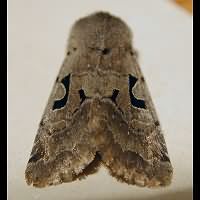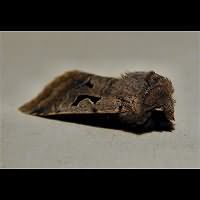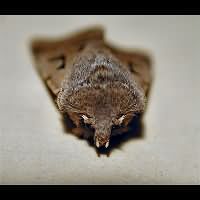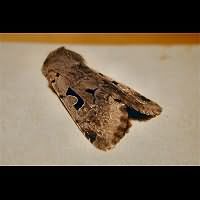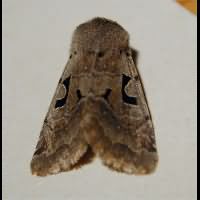Hebrew Character Orthosia gothica
The Hebrew Character has a greyish basic colour usually. Furthermore it has a distinct and striking black marking on the wing. But what does it represent? We think it is a Hebrew sign, but Linnaeus thought it to be of Gothic origin. Anyway, no one can be sure. There is another species with an identical marking: the Setaceous Hebrew Character. Both species share other characteristics as well. Yet you'll probably won't mix them up, for usually the Setaceous Hebrew Character starts flying about when the Hebrew Character stops flying. There are few occassions where the black Hebrew marking on the wing is brownish, or fallen apart in two separate markings. Usually however identifying this moth is easy. Something that can not be said of most other Drabs and Quakers belonging to the Orthosia genus. The wingspan of the Hebrew Character is 30 to 40mm.
The first eggs are being laid in March. And as these hatch after only ten days, the first caterpillars can be seen in March as well. They start by eating the host plants buds, then the leaves. The larvae feed by night only. During daytime they sit motionless hidden in the food plant. The caterpillars are fullgrown in June or July. They move to the ground, dig a hole there and go underground. There they spin a firm cocoon in which they pupate. Usually the pupa overwinters, but during very mild winters some moths will hatch in January or February. The caterpillar itself is green with small yellow spickles. Most striking is a broad white or whitish yellow line running over the spiracula. The length of the full grown caterpillars varies between 42 and 47mm. Very many plants are known to be host to the larvae of the Hebrew Character. They include trees such as oak and sallow, bushes, such as hawthorn and lower plants including dandelions and various cloaver species.
All moths of the genus Orthosia are on the wing in spring, including the Hebrew Character. It flies about in March and April mainly, but a little later in the north of Britain. The cold doesn't seem to irritate the animal, for it also flies in frosty nights. It starts flying far after midnight though. In the wild it is attracted to catkins. But sugar or lights will also attract these moths. Easily photographed during the day, the animal will even tolerate a bit of manipulation. The Hebrew Character has no preference to habitat at all and may be found in forests and gardens alike. Common all over the British Isles including Orkney and Shetland. Very common in Western, Central and Northern Europe as well.
The Hebrew Character has a greyish basic colour usually. Furthermore it has a distinct and striking black marking on the wing. But what does it represent? We think it is a Hebrew sign, but Linnaeus thought it to be of Gothic origin. Anyway, no one can be sure. There is another species with an identical marking: the Setaceous Hebrew Character. Both species share other characteristics as well. Yet you'll probably won't mix them up, for usually the Setaceous Hebrew Character starts flying about when the Hebrew Character stops flying. There are few occassions where the black Hebrew marking on the wing is brownish, or fallen apart in two separate markings. Usually however identifying this moth is easy. Something that can not be said of most other Drabs and Quakers belonging to the Orthosia genus. The wingspan of the Hebrew Character is 30 to 40mm.
The first eggs are being laid in March. And as these hatch after only ten days, the first caterpillars can be seen in March as well. They start by eating the host plants buds, then the leaves. The larvae feed by night only. During daytime they sit motionless hidden in the food plant. The caterpillars are fullgrown in June or July. They move to the ground, dig a hole there and go underground. There they spin a firm cocoon in which they pupate. Usually the pupa overwinters, but during very mild winters some moths will hatch in January or February. The caterpillar itself is green with small yellow spickles. Most striking is a broad white or whitish yellow line running over the spiracula. The length of the full grown caterpillars varies between 42 and 47mm. Very many plants are known to be host to the larvae of the Hebrew Character. They include trees such as oak and sallow, bushes, such as hawthorn and lower plants including dandelions and various cloaver species.
All moths of the genus Orthosia are on the wing in spring, including the Hebrew Character. It flies about in March and April mainly, but a little later in the north of Britain. The cold doesn't seem to irritate the animal, for it also flies in frosty nights. It starts flying far after midnight though. In the wild it is attracted to catkins. But sugar or lights will also attract these moths. Easily photographed during the day, the animal will even tolerate a bit of manipulation. The Hebrew Character has no preference to habitat at all and may be found in forests and gardens alike. Common all over the British Isles including Orkney and Shetland. Very common in Western, Central and Northern Europe as well.

